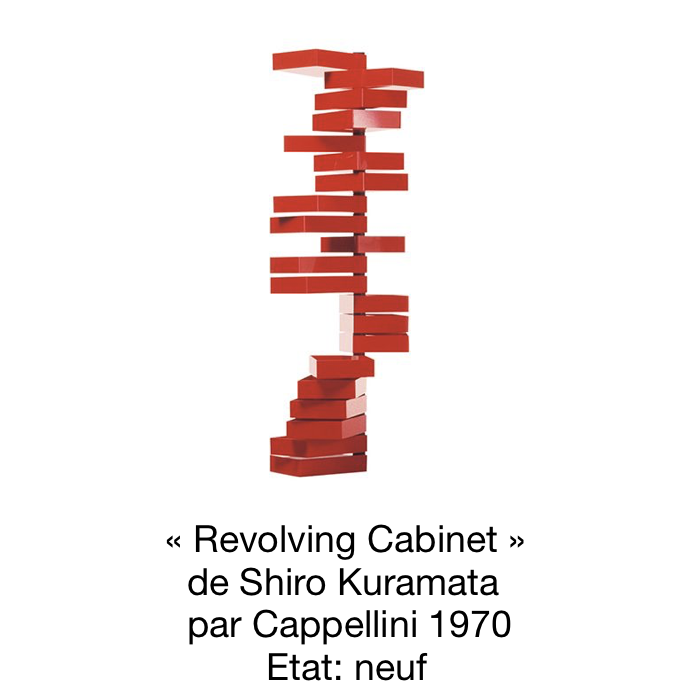Meuble
« Revolving Cabinet »
Shiro Kuramata
Année 1970
cappellini
Etat: Neuf
Prix sur demande

Description:
The Revolving Cabinet looks like a mobile sculpture: light and innovative, it is the perfect emblem of the projects designed by Shiro Kuramata.Revolving Cabinet is made of a glossy red acrylic plastic material, and is equipped with 20 drawers that rotate around a vertical metal stand.
Le Cabinet tournant ressemble à une sculpture en mouvement : léger et innovant, il est le parfait emblème des projets du designer Shiro Kuramata.Le cabinet tournant est fait de plastique acrylique rouge brillant et est équipé de 20 tiroirs qui tournent autour d’un support métallique vertical.
DÉTAILS TECHNIQUES :
Couleur : Rouge
Finition : Plastique acrylique
Dimensions : L 35cm x l 25cm, H 185cm
Poids : 65 kg
Shiro Kuramata
A design icon, Shiro Kuramata was the Japanese designer who best epitomized the spirit of the era in which he lived, through his highly significant products and creations. In 1965, he founded the Kuramata Design Office in Tokyo, where he remained until the year of his death, in 1991, working on numerous projects that entered the product and Design hall of fame.Kuramata first encountered Italian design through Memphis, then in 1987, with Cappellini, for whom he created the Progetti Compiuti chest of drawers series. All of the pieces Kuramata made for the company were incredibly well-received, such as the Steel Pipe Drink Trolly, the Sofa With Arms, the Ko.Ko. table, the Revolving Cabinet bookshelf and chest of drawers. Kuramata’s designs are still remarkably modern, and many can be found in the permanent collections of the Museum of Decorative Arts in Paris, the MoMA in New York, the Metropolitan Museum, the Vitra Design Museum, and the Museum of Modern Art of Toyama.
Icône du design, Shiro Kuramata est le designer japonais qui a le mieux interprété l’esprit de son temps avec des produits et des réalisations significatives. En 1965, il a fondé le bureau de design Kuramata à Tokyo, qui est resté en existence jusqu’en 1991, l’année de sa mort, comptant de nombreux projets qui sont entrés dans l’Olympe du design de produits. Kuramata est d’abord entré en contact avec le design italien par l’intermédiaire de Memphis, puis, en 1987, avec Cappellini qui a introduit la famille de blocs-tiroirs Progetti Compiuti dans la collection. Toutes les pièces réalisées par Kuramata pour l’entreprise sont très appréciées, comme le chariot à boissons Steel Pipe, le fauteuil Sofa With Arms, la table basse Ko.Ko, la bibliothèque Revolving Cabinet et la commode.Tous les projets de Kuramata sont encore extrêmement actuels et font partie des collections permanentes du Musée des arts décoratifs de Paris, du MoMa de New York, du Metropolitan Museum, du Vitra Design Museum et du Toyama Museum of Modern Art.
